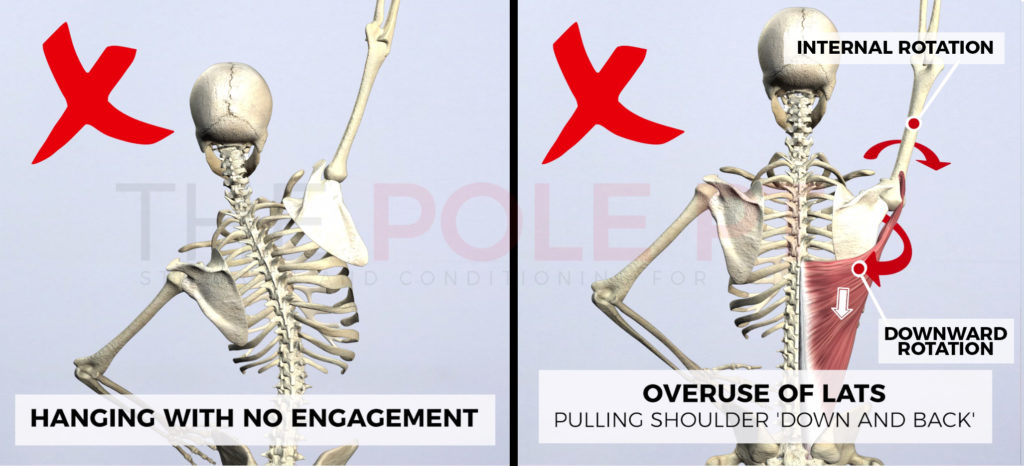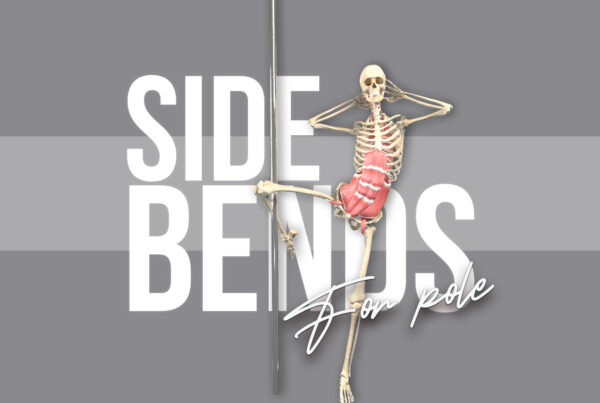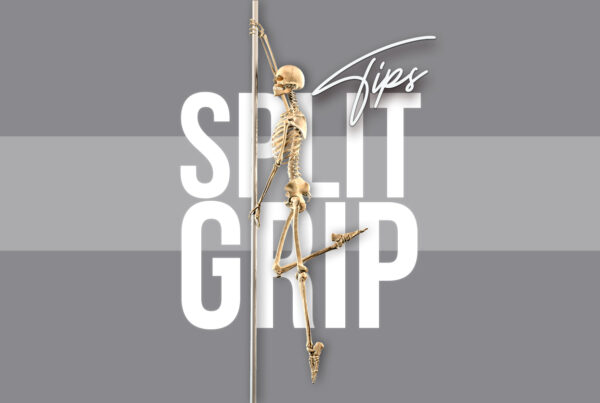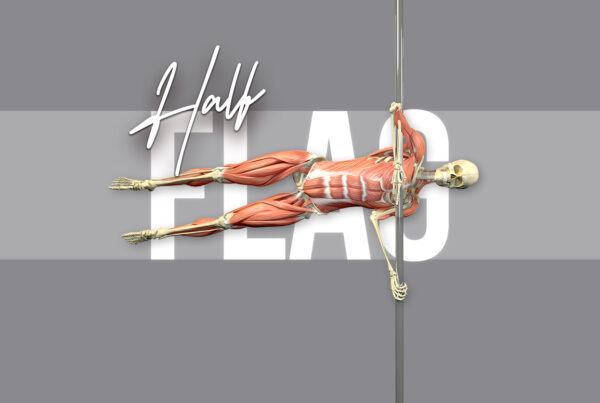First, a quick catch up in case you missed parts 1 and [2] of this pole shoulder engagement series…
In PART 1, we discussed what ‘good’ shoulder mechanics looks like in an overhead position – and particularly how we should be engaging in an overhead PUSH – like when we’re doing a handstand or Ayesha.
In PART 2, we flipped this ‘right way around’, to see what this ‘good’ shoulder mechanics looks like in an overhead PULL – like when we’re doing a pole spin or climb.
We’ve talked about how our enthusiastic lats can get a little over-eager when we’re pulling overhead. Today, I want to explore that a little further and talk about how we can train the magical sweet spot of shoulder engagement that will give us those 4 key elements of ‘good’ overhead shoulder mechanics, without that lat-driven ‘down and back’ action.
4 Key elements of overhead shoulder engagement
1. Upward rotation of the shoulder blade;
2. Posterior tilt of the shoulder blade;
3. Wrapping of the shoulder blade, staying hugged to the rib cage;
4. External rotation of the arm.

Step aside, lats!
To recap from PART 2… in a pole spin, with gravity pulling our body down, we effectively need to lift our body UP – or, put another way: pull our shoulder blade DOWN to keep it anchored on our rib cage.
This is why you will often hear your pole instructor say things like “shoulders down and back” for spins, pole walks and climbs.
That ‘down and back’ cue helps to prevent us from hanging off the shoulder joint, which we definitely want to avoid.
BUT, because our lats are such a big muscle and can be, let’s say… a little bit keen… we have a tendency to use our lats to create this down and back action, instead of our mid and lower traps.
The problem with this is that our latisimus dorsi actually pulls our shoulder blade into depression, creating downward rotation and also internal rotation of the arm = the opposite of what we want for that ‘good’ shoulder mechanics!

So, how do we encourage those 4 key elements of overhead shoulder engagement while also pulling ‘down’ to keep our shoulder blade on our rib cage, WITHOUT excessively using our lats?
Say hello to your mid and lower traps!
The answer is that we need to focus more on engaging our mid and lower traps to keep our shoulder blade anchored to our body!

This is a much more subtle feeling than engaging our lats and can be difficult to understand and cue.
As always, a good starting point is with some OFF the pole exercises. Once your body and brain are nodding in agreement with this, THEN we start to take this onto the pole – and THEN we can start to progressively add load to it.
Here are my 3 favourite ‘off the pole’ exercises, plus a couple of ‘on the pole’ exercises you can use to start experimenting with this.
OFF THE POLE SHOULDER ENGAGEMENT EXERCISES
Exercise 1: Serratus Slide on pole
This exercise focuses on the engagement of our serratus anterior. That’s the finger like muscle at the side of our body which helps to drive upward rotation of the shoulder blade and keep the shoulder blade hugged to our rib cage.
The main thing to focus on here is making sure you are actively pushing into the pole and thinking about getting that scapula wrapping as you lift the arm overhead. It can help to imagine that you are pressing the bottom edge of your shoulder blade up into your arm pit.
Exercise 2: Wall angels
In this second exercise, we’re starting to add some external rotation and posterior scapula tilt by keeping the elbows off the wall as we lift the arms overhead.
Your goal is to keep your lower back and the back of your hands on the wall as you lift the arm overhead. BUT I want you to bring the elbows away from the wall just a couple of inches as you lift – that should help to encourage that posterior tilt of the scapula and create external rotation of the arm.
It’s important that you don’t arch the back in this exercise – so keep your core engaged and back flat against the wall!
Exercise 3: Child’s pose arm lifts
In this third exercise, we’re really starting to combine everything together – we’re pushing forwards to encourage that upward rotation of the scapula ✔ rotating our elbows towards the floor for that external rotation of the arm ✔ and pressing the bar UP towards the ceiling to encourage engagement of those lower traps. ✔
Because we’re in a child’s pose, it’s very hard to ‘cheat’ because we cannot arch our back, even if we really, really wanna! Prepare to be humbled by this simple-looking movement!
ON THE POLE SHOULDER ENGAGEMENT EXERCISES
When you’ve been doing these exercises regularly and have started to get that mind-muscle connection of how this should all feel – go you! It’s time to take it to the pole.
Exercise 1: Isometric overhead pole push
Pole exercise 1 is all about the overhead push. We’re doing this exercise in a position that simulates the bottom arm of the Ayesha, but with our feet on the floor.
In our Ayehsa, it’s our bottom arm that is pushing, but here, because we’re ‘right away around’, it’s our top arm that’s doing the pushing. This may feel a little counterintuitive at first, because when we’re ‘right way around’ we’re usually pulling with that top arm, but stick with it. This is a great drill for training the engagement for that active push in a deloaded position, to help prepare your shoulder for the Ayesha.
Think about all of the things that we’ve worked on – the upward rotation and posterior tilt of the shoulder blade, the engagement of the lower traps and the external rotation of the arm. You should be working them all here and actively pushing into a shrug position.
You can later add a pull with the bottom arm, to really start to get the push-pull feeling of the Ayesha – you can do this in all the Ayesha grips, too!
Exercise 2: Isometric overhead pole pull
Our final pole exercise for shoulder engagement is a tricky one, so I’ve explained this to camera in the video below.
At first, creating that ‘shoulders down’ action from your lower traps can feel a little bit like trying to flap your ear around like Sloth in Goonies. It may just feel like there is no connection there between your brain and the muscle. But be patient. Play around with it.
Note the difference in feeling if you aggressively squeeze the shoulder down and back using your lats vs focusing on bringing your body up using your lower traps. It’s subtle, but over time, I promise you CAN develop more control over this!
When done regularly, you can teach your body what this engagement feels like. Eventually, that will begin to transfer to your movements on the pole, too.
Want ‘done for you’ programming to help you incorporate these exercises into your training? >> Download my Pole Proof Shoulder programme today!
Wanna learn the ‘hows and whys’ behind training for pole and how to build your own customised training programme? >> Check out my book, Strength and Conditioning for Pole!
*This post is for information purposes only* We are all unique and special unicorns. What makes sense for one pole dancer’s body may not make sense for another! The movements discussed in this post may not be suitable for you – particularly if you have any pain or previous shoulder injuries. Not sure? See a physiotherapist, preferably one that specialises in working with aerial artists, to help you understand your body’s individual quirks and needs!
Speaking of which! Here’s a shout out to my favourite aerial physio – The Circus Doc – Dr Emily Scherb! Emily’s courses on hanging in aerial arts have really helped to solidify my own understanding of how this all works. If you’re a body nerd like me, you’ll love The Circus Doc anatomy education courses, too! I can’t recommend them enough – go check ‘em out here! Go! Go! There’s much more nerding to be done!*
*Just so you know, I earn a commission if you use this link, but I’d never recommend products to you that I don’t use and love myself!








